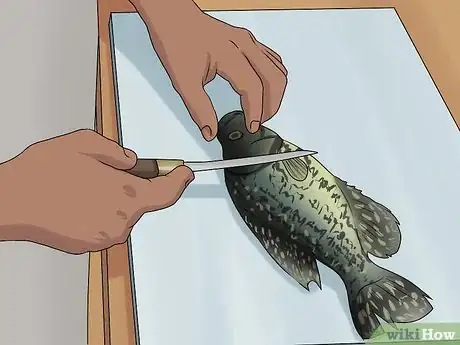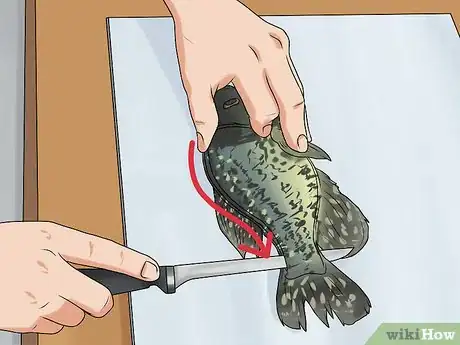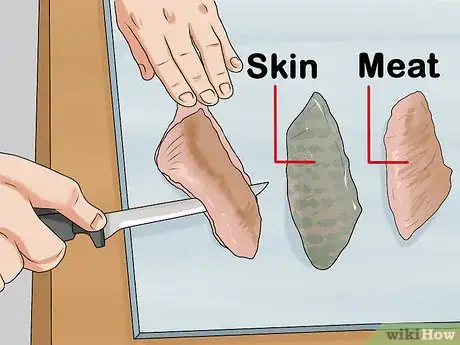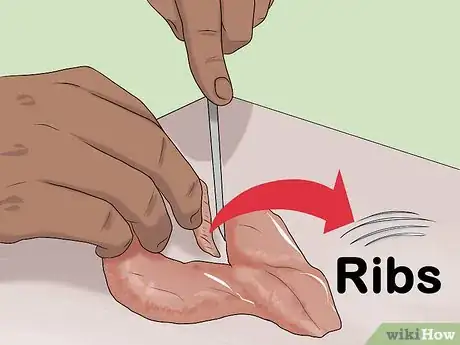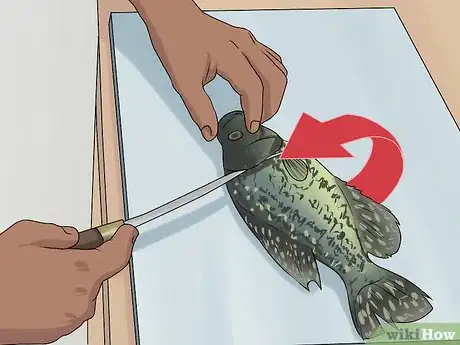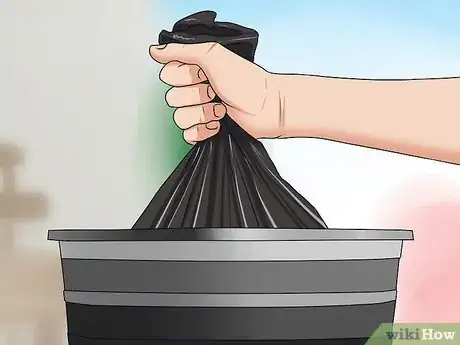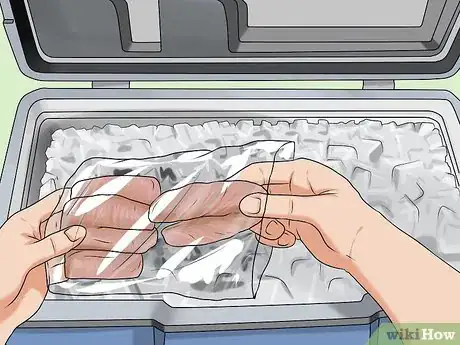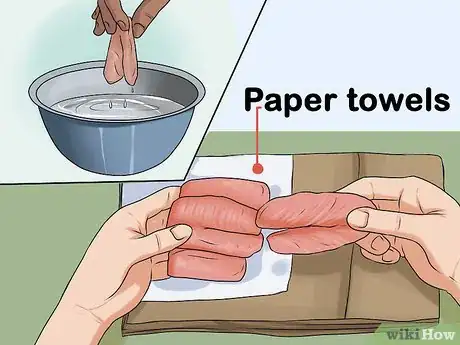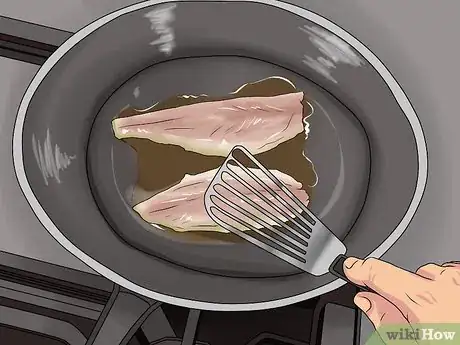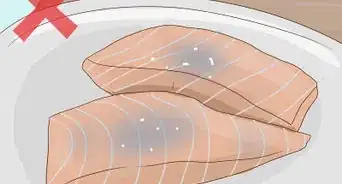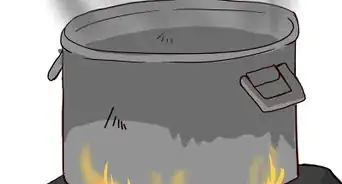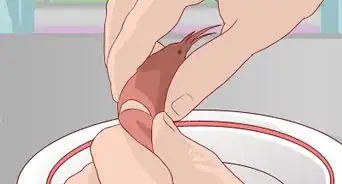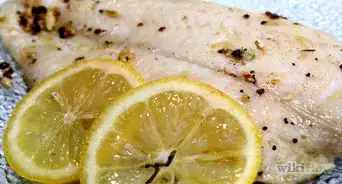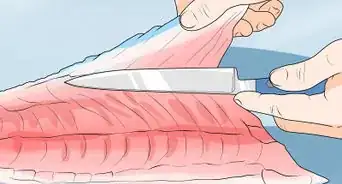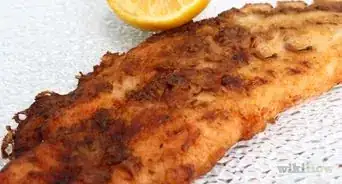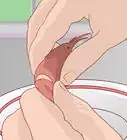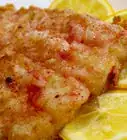This article was co-authored by wikiHow Staff. Our trained team of editors and researchers validate articles for accuracy and comprehensiveness. wikiHow's Content Management Team carefully monitors the work from our editorial staff to ensure that each article is backed by trusted research and meets our high quality standards.
There are 11 references cited in this article, which can be found at the bottom of the page.
This article has been viewed 90,908 times.
Learn more...
After a long day on the river, there’s no better reward than bringing back a haul of fat, delicious crappie. But your work isn’t complete until the fish have been dressed and are ready for the frying pan or the freezer. Fortunately, you don’t have to be an expert outdoorsman to prepare your fresh catch. Cleaning crappie isn’t a particularly complicated process—all it requires is a single knife and a working knowledge of the fish’s anatomy.
Steps
Filleting the Crappie
-
1Lay the crappie flat against the cutting surface. Place the fish horizontally with its tail on the same side as your dominant hand. This will allow you to work more fluidly. Hold the crappie by the head as you prepare to make your first cut.[1]
- If you’re right-handed, the head of the fish should be to your left; if you’re left-handed, arrange it so that it’s on your right.
- Assuming you don’t have access to a cutting board, look for another level surface to set the crappie on, like a smooth rock or the edge of the boat.[2]
-
2Make a vertical cut just behind the gills. Insert the tip of the knife between the back of the gill plate and the pectoral fin. Cut into the gills at a slight angle toward the head. Continue cutting until you reach the backbone, but be careful not to sever it.[3]
- It’s important to keep the backbone intact, as you’ll use it as a guide when cutting.
- Carving along the backbone will enable you to fillet the fish without the need to first remove the head or tail.
Advertisement -
3Turn your knife horizontally in the cut. Once you’ve made contact with the backbone, keep the blade in the incision and twist it until the edge points toward the tail. If you do this correctly, there will be no need to make any other clumsy cuts.[4]
- The first cut is intended to open up the fish and create an entry point that you can then use to strip the fillet.
- Angle the blade downward to keep the edge as close to the skin as possible.
-
4Run the blade along the backbone to the tail. Holding the head firmly, begin dragging the knife steadily down the entire length of the crappie. Rather than attempting to saw through the skin, simply push the blade and let the meat come free. Stop when you reach the rear section of the fish near the tail.[5]
- If you’re cutting close enough to the backbone, you should be able to feel the contours of each individual rib as you push the knife through.[6]
- Holding the loose flap with your opposite hand while you cut can give you a little extra leverage and stability.
-
5Separate the meat from the skin. Peel back the fillet so that it’s laying flat against the cutting surface. Then, starting at the tail, slide the edge of the knife between the skin and meat and make a clean pass from one end to the other. The fillet should lift away in one smooth piece.[7]
- Keep the blade tilted slightly downward to avoid cutting into the meat.
- You also have the option of leaving the skin on until after you cook the crappie. It fries up nice and crispy, and can be quite flavorful.
-
6Remove the ribcage. Toward the head end of the fillet you’ll find the ribcage still attached. Use the curved tip of the knife to trace around the edges of the ribcage, being careful not to waste any meat. The deboned fillet should have a ‘V’ shape.[8]
- Look closely for the ribcage after peeling back the first fillet. It may not be immediately visible if it's covered up by meat or other tissues.
- Don’t worry if there are one or two rib bones left behind—you can pry these out with your knife, a pair of tweezers or the tines of a fork.
-
7Repeat on the opposite side. Turn the fish over and follow the same procedure, starting with a vertical cut behind the gills. When you’re finished, be left with two fillets that you can then cook or put away for later.[9]
-
8Dispose of the unused parts of the fish. Keep a trash receptacle nearby as you work so you’ll have someplace to drop the discarded bones, skin and entrails. Fish gives off an unpleasant odor as it decomposes, so it’s best to put the unused bits in a separate bag that you can close and tie off before tossing them out.[10]
- Raw fish tends to be full of bacteria and can become a health concern if not thrown out right away.
Using and Storing Your Fresh Catch
-
1Put the fillets on ice. If you’re cleaning the crappie on site, be sure to bring along a cooler to keep them cold. That way, you can be certain that they'll stay fresh until you can get them home. You can stick the whole fish in the cooler, or dress them immediately and chill the fillets in plastic bags to make better use of the space you have available.[11]
- If possible, use saltwater ice. The salt will help preserve the fish even more efficiently.[12]
- Make sure the cooler you bring is big enough to pack in a bountiful harvest.
-
2Rinse the fillets before cooking or storing. Run the crappie under a stream of cool water to wash off any blood, scales or other tissue. Let the excess water drip off, then pat the fillets with a layer of folded paper towels to soak up some of the moisture from inside the fish.[13]
- Watery fish can be difficult to cook properly, and will often turn out with a dull flavor.
-
3Cook the crappie right away. The best way to enjoy crappie is fresh out the water. Put the fillets on ice until it’s time to eat, then grill, broil or deep fry them, or simply throw them in a hot pan with with some oil and a dash of salt and pepper. The mild, slightly sweet flavor of the fish lends itself well to a variety of dishes.
- The less time the crappie spends exposed to warm temperatures, the better it will taste.
- Use crappie in some of your favorite recipes that call for freshwater fish.[14]
-
4Store the crappie in the refrigerator or freezer. If you’re not planning on serving your catch immediately, it’s important to keep them at a temperature below about 40°F (4.5°C). Get them back home as soon as you call it a day. You can cover them in plastic wrap and tuck them away in one of the drawers in your refrigerator, or vacuum seal and freeze them until you’re ready to whip up a fish dinner.[15]
Warnings
- Handle the knife with care. The smallest slip could result in serious injury, especially when wet, slippery hands are involved.⧼thumbs_response⧽
- Inspect the meat carefully before eating it. Crappie and other species of freshwater panfish have been known to harbor parasites which can be harmful if ingested.[18]⧼thumbs_response⧽
Things You'll Need
- Filleting knife
- Cutting board or similar surface
- Cut glove
- Cooler and ice (for keep fish fresh)
- Tweezers
- Plastic wrap or wax paper
- Vacuum seal bags
References
- ↑ http://goneoutdoors.com/clean-crappie-7238514.html
- ↑ https://extension.psu.edu/proper-field-dressing-and-handling-of-wild-game-and-fish
- ↑ http://www.scout.com/outdoors/wired2fish/story/1601840-how-to-clean-crappie-with-a-fillet-knife
- ↑ http://goneoutdoors.com/clean-crappie-7238514.html
- ↑ http://www.gameandfishmag.com/recipes/how-to-fillet-a-crappie/
- ↑ http://www.scout.com/outdoors/wired2fish/story/1601840-how-to-clean-crappie-with-a-fillet-knife
- ↑ https://www.youtube.com/watch?v=MmUDb1O46HM
- ↑ http://www.scout.com/outdoors/wired2fish/story/1601840-how-to-clean-crappie-with-a-fillet-knife
- ↑ https://www.youtube.com/watch?v=MmUDb1O46HM
- ↑ https://1source.basspro.com/index.php/component/k2/237-fishing-info/2739-6-easy-how-to-steps-to-fillet-bass-crappie-perch-infographic
- ↑ https://www.takemefishing.org/how-to-fish/how-to-catch-fish/how-to-store-a-fish/
- ↑ http://www.bishfish.co.nz/articles/general/icecold.htm
- ↑ https://www.reserveamerica.com/outdoors/how-to-clean-a-fish.htm
- ↑ http://dish.allrecipes.com/cooking-fresh-fish/
- ↑ https://www.takemefishing.org/how-to-fish/how-to-catch-fish/how-to-store-a-fish/
- ↑ https://www.takemefishing.org/how-to-fish/how-to-catch-fish/how-to-store-a-fish/
- ↑ https://1source.basspro.com/index.php/component/k2/237-fishing-info/2739-6-easy-how-to-steps-to-fillet-bass-crappie-perch-infographic
- ↑ http://www.seafoodhealthfacts.org/seafood-safety/general-information-patients-and-consumers/seafood-safety-topics/parasites
About This Article
To clean crappie, start by making a cut just behind the gills until you reach the backbone. Then, turn the blade in the incision so it points towards the tail. Next, hold onto the head and run the blade along the backbone towards the tail. When you're close to the tail, peel back the fillet so it's flat on the cutting surface, and run the knife between the skin and the meat. Finish the first fillet by cutting out the ribcage with the curved end of the knife, then repeat the entire process to fillet the other side of the fish. For tips on how to store crappie fillets and how to cook them, read on!
